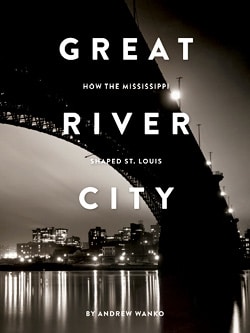Vivian Gibson, 160 pages, nonfiction, Belt Publishing, paperback, $14.95
Imagine yourself in a city or a neighborhood in which you used to live. Maybe you’re out on a Sunday drive showing your kids the house you grew up in just across town. Seeing life carry on in a place we were so intimately familiar with at one time can be kind of unsettling. There’s a sense of nostalgia for a time in our lives and a part of ourselves that’s no longer here. Now imagine the street you lived on was bulldozed, cleared away, and subsumed by an interstate highway and new unfamiliar developments. That was the case for St. Louis author Vivian Gibson, whose memoir The Last Children of Mill Creek details her upbringing in a downtown St. Louis-adjacent neighborhood that is no longer there.
The introduction lays out the broad strokes of the Mill Creek Valley neighborhood’s history, as well as how she came to grow up there. Mill Creek flowed from a spring eastward until it emptied into the Mississippi River. It took its name from a grist mill that was established on its banks and over time developed into a neighborhood. At first there were bucolic country homes along its shores, but those gave way over time to “smoke-belching factories and foul-smelling slaughterhouses.” The creek was drained in 1852 and replaced decades later by railroad tracks, but the community clung, for a time, to its name. Long after the stream was gone, her parents settled in Mill Creek to raise their children. Her father was the son of Arkansas sharecroppers, and her mother was the daughter of a grocery store owner that catered to the Black populace in a small Alabama town.
Segregation, White flight, redlining—all of these phenomena played out in St. Louis, at times more acutely than in other cities across the country. The upshot was that Mill Creek Valley, long abandoned by St. Louis’s White residents but occupying potentially profitable downtown real estate, was slated by the city to be condemned or purchased plat by plat, then cleared to make way for what was euphemistically referred to as “urban renewal” but in actuality was the displacement of a viable neighborhood twenty-thousand strong.
Gibson’s grandmother was unaware of such plans when she purchased her Mill Creek home for one thousand dollars in 1950. This was the house in which Gibson grew up. For a time, the narrative plays out in a way that will feel recognizable to most readers. As her memoir unfolds, we relive formative childhood memories such as getting reprimanded for neglecting chores when her father arrived home from his long days on the job and playing with paper dolls. At one point her father is laid up in a hospital for three months recovering from a hit and run, and Gibson walks us through how the family adapts.
Running through the narrative like the long-gone Mill Creek waterway is the racial tension of the era and the city itself. Its influence is palpable even if it isn’t always referred to by name. In some cases, Gibson simply describes a scene rife with racial tension and allows the reader to take from it what they will, without offering much commentary of her own. The effect renders the narrative all the more immersive. It’s easy to feel as though Gibson has placed a camera just over her shoulder and given the reader access to the footage of her upbringing in a community that would soon cease to exist.
Gibson’s memoir deals with coming of age, loss, the illusory quality of memory, race, and much more in a digestible 160-page package that one could tear through on a single weekend afternoon. It’s written with a kind of literary efficiency, spare but descriptive, which leaves you feeling captivated and close to the momentum of the narrative.
There’s so much to gain from reading this memoir. One of the highest purposes a book can achieve is to offer us new insight into lives lived differently than our own. If you didn’t happen to grow up as a Black American in the middle of the twentieth century in a neighborhood that has since been demolished to make way for lucrative development projects, chances are you will get an intimate glimpse of a new perspective.
More Great Reads
By Amy Stapleton
The Steamboat Era: A History of Fulton’s Folly on American Rivers, 1807-1860
S. L. Kotar and the late J. E. Gessler, 307 pages, nonfiction, McFarland Press, softcover, $39.95.
The St. Louis authors have compiled firsthand accounts of accidents and routines of passengers and crew from the steamboat era to make the early to mid-1800s come alive. A useful glossary of steamboat terms is also included.
Major General Philip Kearny: A Soldier and His Time in the American Civil War
Robert R. Laven, 210 pages, nonfiction, McFarland Press, softcover, $35.
Philip Kearny was a Union general with a lifetime of experience gained by leading his men in wars. He trained at Jefferson Barracks in Missouri. The author, from Creve Coeur, chronicles the service of a man who once led a charge with his horse’s reins in his teeth.
Iconic Restaurants of St. Louis
Ann Lemon Pollack, 160 pages, nonfiction, Arcadia Publishing and The History Press, softcover, $21.99.
The author features forty-one iconic restaurants from St. Louis’s and surrounding suburbs’ past and present, such as Annie Gunn’s, Tony’s, and Ted Drewes Frozen Custard. The book serves nostalgia and inspiration as well, with sixteen recipes, including Harry S. Truman’s favorite cheese soup.
Hope Sees Her Condor
Lester Feldman, 24 pages, fiction, Houts and Home Publications, LLC, softcover, $9.99.
This Maryville publisher presents a charming children’s book based on a trip taken by the author and his granddaughter to see a condor in the mountains. The author also did the illustrations.
Notorious Missouri: 200 Years of Historic Crimes
James W. Erwin and Vicki Berger Erwin, The History Press, nonfiction, softcover, $21.99.
The duel on Bloody Island, the murder of a prominent Mexico, Missouri, woman, the trials of the alleged murderer of Colonel Thomas Swope, and many more notorious crimes are told with great detail and historical photos.
Fair Grove: Home of the Wommack Mill
Complied by Marilyn Smith, 259 pages, nonfiction, Lily Press, Inc., hardcover, $30.
The author gathered and compiled historical photos, newspaper stories, and the history of the town and surrounding areas into this book.
St. Louis Fire Stations
Robert Pauly with Dennis J. Maag, 160 pages, nonfiction, Reedy Press, hardcover, $36.
Filled with more than 160 rare historical photos as well as the details of each station, this book tells the story of these pillars of many communities. The book finishes with full-color photos of thirty-eight stations still in operation today.
Related Posts
Book Review: Great River City
A new coffee table book looks beneath the surface of St. Louis’s river history
Book Review: Midwest Architecture Journeys
A new title from Belt Publishing explores the architecture of the region.
Book Review: Prairie Wildflowers
Prairie Wildflowers provides a companion on journeys through Missouri’s grasslands and beyond.



